Economics Assignment: Micro and Macroeconomic Principles
VerifiedAdded on 2020/05/03
|11
|1700
|177
Homework Assignment
AI Summary
This economics assignment delves into fundamental economic principles, beginning with the laws of supply and demand illustrated through graphical representations. It then analyzes market dynamics, including the impact of technological advancements on supply and demand, using the example of iPads. The assignment explores market failures, such as monopolies, and examines oligopolistic market structures, using the Australian banking sector as a case study. Part B of the assignment focuses on macroeconomic issues, specifically inflation, unemployment, and interest rates in Australia. It analyzes data from various sources, including Bloomberg, The Guardian, and ABC News, to discuss the relationship between inflation and unemployment using the Phillips curve, and the role of interest rates. The analysis covers the factors influencing inflation and its impact on the Australian economy, providing a comprehensive overview of both micro and macroeconomic concepts.
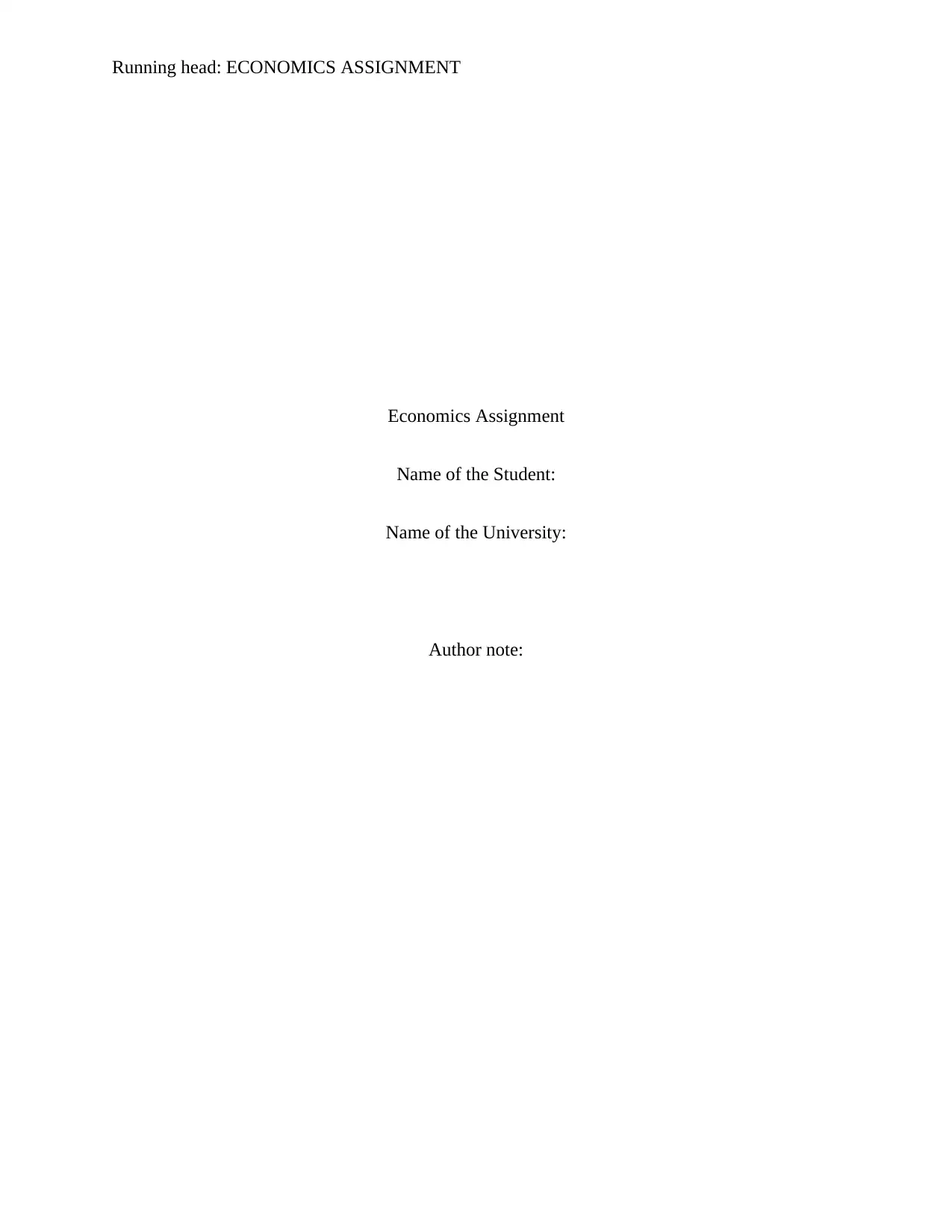
Running head: ECONOMICS ASSIGNMENT
Economics Assignment
Name of the Student:
Name of the University:
Author note:
Economics Assignment
Name of the Student:
Name of the University:
Author note:
Paraphrase This Document
Need a fresh take? Get an instant paraphrase of this document with our AI Paraphraser

D
Price
Quantity demanded
Q1
P1
P2
Q2
A
B
1ECONOMICS ASSIGNMENT
Part A
Answer 1
Laws of demand and supply are the most important principle of economics. The law of
demand says that, if the price of a good or service increases, the demand for the quantity
decreases and when the price of a good or service decreases the demand for that product or
service increases, other things remaining unchanged. Law of supply represents that if price of a
good or service increases, its supply would increase and vice versa, other things being same
(Bruneel et al., 2012).
Figure 1: Law of Demand
(Source: Author)
Price
Quantity demanded
Q1
P1
P2
Q2
A
B
1ECONOMICS ASSIGNMENT
Part A
Answer 1
Laws of demand and supply are the most important principle of economics. The law of
demand says that, if the price of a good or service increases, the demand for the quantity
decreases and when the price of a good or service decreases the demand for that product or
service increases, other things remaining unchanged. Law of supply represents that if price of a
good or service increases, its supply would increase and vice versa, other things being same
(Bruneel et al., 2012).
Figure 1: Law of Demand
(Source: Author)

2ECONOMICS ASSIGNMENT
SPrice
Quantity supplied
Q1
P2
P1
Q2
A
B
Figure 2: Law of Supply
(Source: Author)
In figure 1, when price declines from P1 to P2, the quantity demanded rises from Q1 to
Q2. This represents law of demand. In figure 2, when price rises from P1 to P2, quantity supplied
rises from Q1 to Q2, reflecting law of supply.
SPrice
Quantity supplied
Q1
P2
P1
Q2
A
B
Figure 2: Law of Supply
(Source: Author)
In figure 1, when price declines from P1 to P2, the quantity demanded rises from Q1 to
Q2. This represents law of demand. In figure 2, when price rises from P1 to P2, quantity supplied
rises from Q1 to Q2, reflecting law of supply.
⊘ This is a preview!⊘
Do you want full access?
Subscribe today to unlock all pages.

Trusted by 1+ million students worldwide
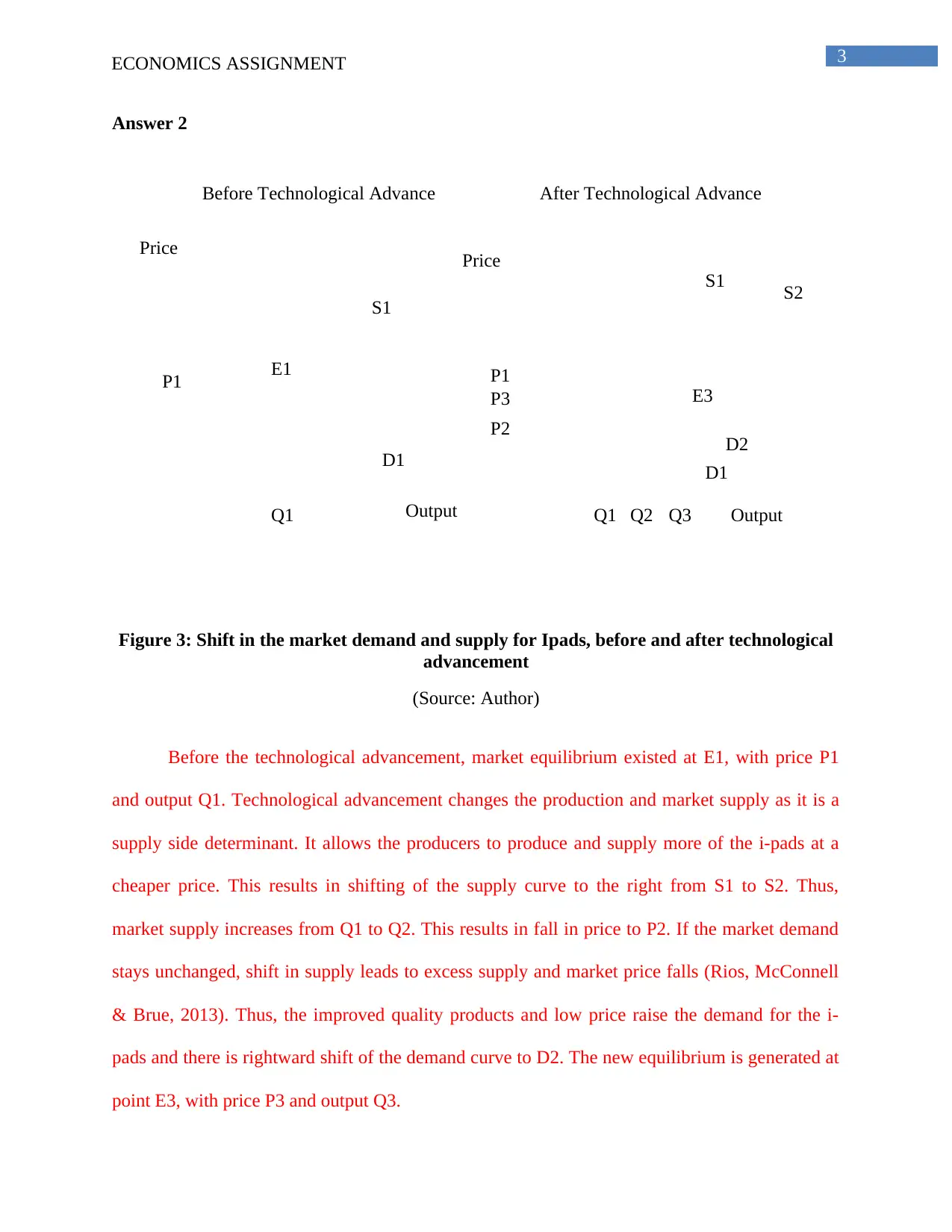
3ECONOMICS ASSIGNMENT
Before Technological Advance After Technological Advance
E3
P1 P3
S1
S1
D1 D1
D2
S2
Q3Q1 Q2
P2
E1
Price Price
OutputOutput Q1
P1
Answer 2
Figure 3: Shift in the market demand and supply for Ipads, before and after technological
advancement
(Source: Author)
Before the technological advancement, market equilibrium existed at E1, with price P1
and output Q1. Technological advancement changes the production and market supply as it is a
supply side determinant. It allows the producers to produce and supply more of the i-pads at a
cheaper price. This results in shifting of the supply curve to the right from S1 to S2. Thus,
market supply increases from Q1 to Q2. This results in fall in price to P2. If the market demand
stays unchanged, shift in supply leads to excess supply and market price falls (Rios, McConnell
& Brue, 2013). Thus, the improved quality products and low price raise the demand for the i-
pads and there is rightward shift of the demand curve to D2. The new equilibrium is generated at
point E3, with price P3 and output Q3.
Before Technological Advance After Technological Advance
E3
P1 P3
S1
S1
D1 D1
D2
S2
Q3Q1 Q2
P2
E1
Price Price
OutputOutput Q1
P1
Answer 2
Figure 3: Shift in the market demand and supply for Ipads, before and after technological
advancement
(Source: Author)
Before the technological advancement, market equilibrium existed at E1, with price P1
and output Q1. Technological advancement changes the production and market supply as it is a
supply side determinant. It allows the producers to produce and supply more of the i-pads at a
cheaper price. This results in shifting of the supply curve to the right from S1 to S2. Thus,
market supply increases from Q1 to Q2. This results in fall in price to P2. If the market demand
stays unchanged, shift in supply leads to excess supply and market price falls (Rios, McConnell
& Brue, 2013). Thus, the improved quality products and low price raise the demand for the i-
pads and there is rightward shift of the demand curve to D2. The new equilibrium is generated at
point E3, with price P3 and output Q3.
Paraphrase This Document
Need a fresh take? Get an instant paraphrase of this document with our AI Paraphraser
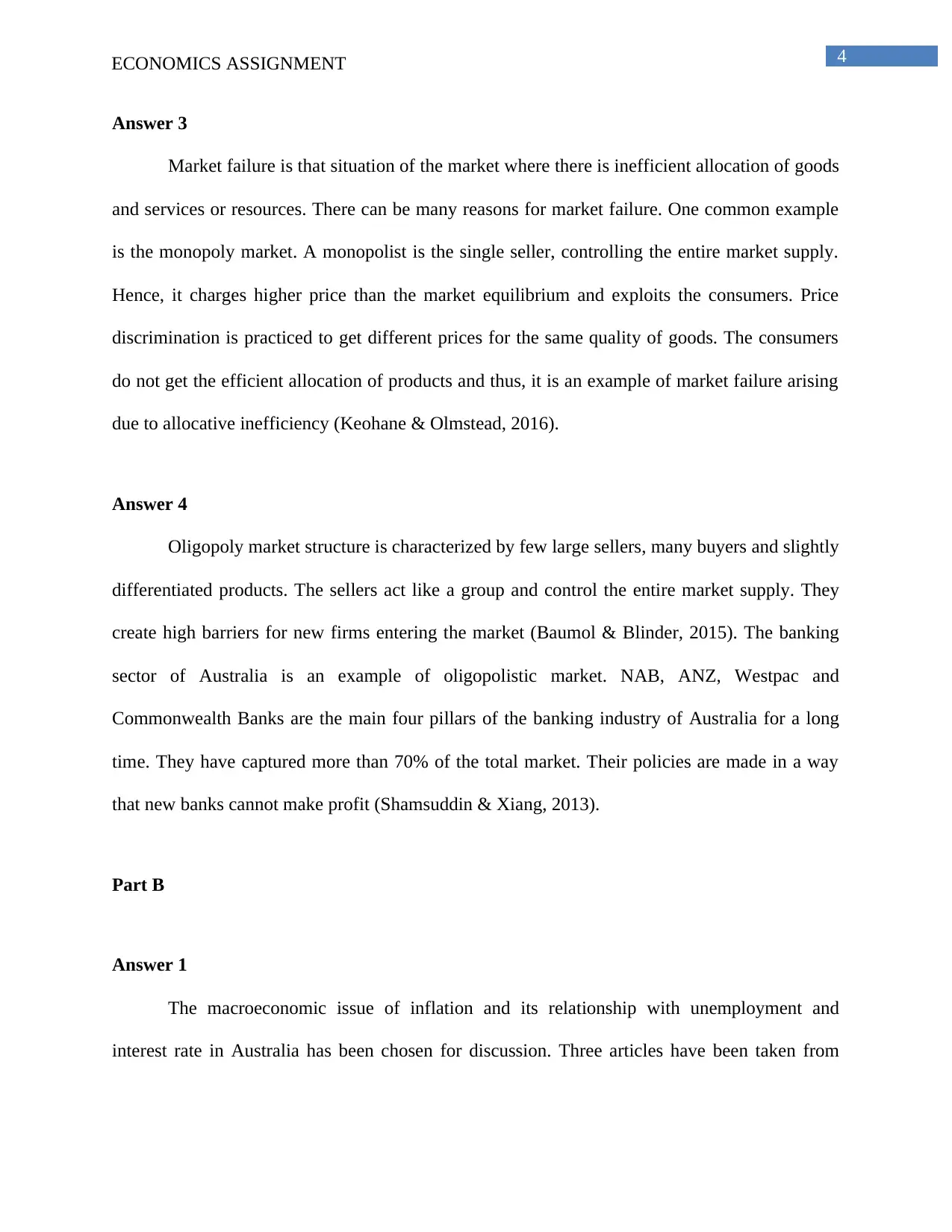
4ECONOMICS ASSIGNMENT
Answer 3
Market failure is that situation of the market where there is inefficient allocation of goods
and services or resources. There can be many reasons for market failure. One common example
is the monopoly market. A monopolist is the single seller, controlling the entire market supply.
Hence, it charges higher price than the market equilibrium and exploits the consumers. Price
discrimination is practiced to get different prices for the same quality of goods. The consumers
do not get the efficient allocation of products and thus, it is an example of market failure arising
due to allocative inefficiency (Keohane & Olmstead, 2016).
Answer 4
Oligopoly market structure is characterized by few large sellers, many buyers and slightly
differentiated products. The sellers act like a group and control the entire market supply. They
create high barriers for new firms entering the market (Baumol & Blinder, 2015). The banking
sector of Australia is an example of oligopolistic market. NAB, ANZ, Westpac and
Commonwealth Banks are the main four pillars of the banking industry of Australia for a long
time. They have captured more than 70% of the total market. Their policies are made in a way
that new banks cannot make profit (Shamsuddin & Xiang, 2013).
Part B
Answer 1
The macroeconomic issue of inflation and its relationship with unemployment and
interest rate in Australia has been chosen for discussion. Three articles have been taken from
Answer 3
Market failure is that situation of the market where there is inefficient allocation of goods
and services or resources. There can be many reasons for market failure. One common example
is the monopoly market. A monopolist is the single seller, controlling the entire market supply.
Hence, it charges higher price than the market equilibrium and exploits the consumers. Price
discrimination is practiced to get different prices for the same quality of goods. The consumers
do not get the efficient allocation of products and thus, it is an example of market failure arising
due to allocative inefficiency (Keohane & Olmstead, 2016).
Answer 4
Oligopoly market structure is characterized by few large sellers, many buyers and slightly
differentiated products. The sellers act like a group and control the entire market supply. They
create high barriers for new firms entering the market (Baumol & Blinder, 2015). The banking
sector of Australia is an example of oligopolistic market. NAB, ANZ, Westpac and
Commonwealth Banks are the main four pillars of the banking industry of Australia for a long
time. They have captured more than 70% of the total market. Their policies are made in a way
that new banks cannot make profit (Shamsuddin & Xiang, 2013).
Part B
Answer 1
The macroeconomic issue of inflation and its relationship with unemployment and
interest rate in Australia has been chosen for discussion. Three articles have been taken from
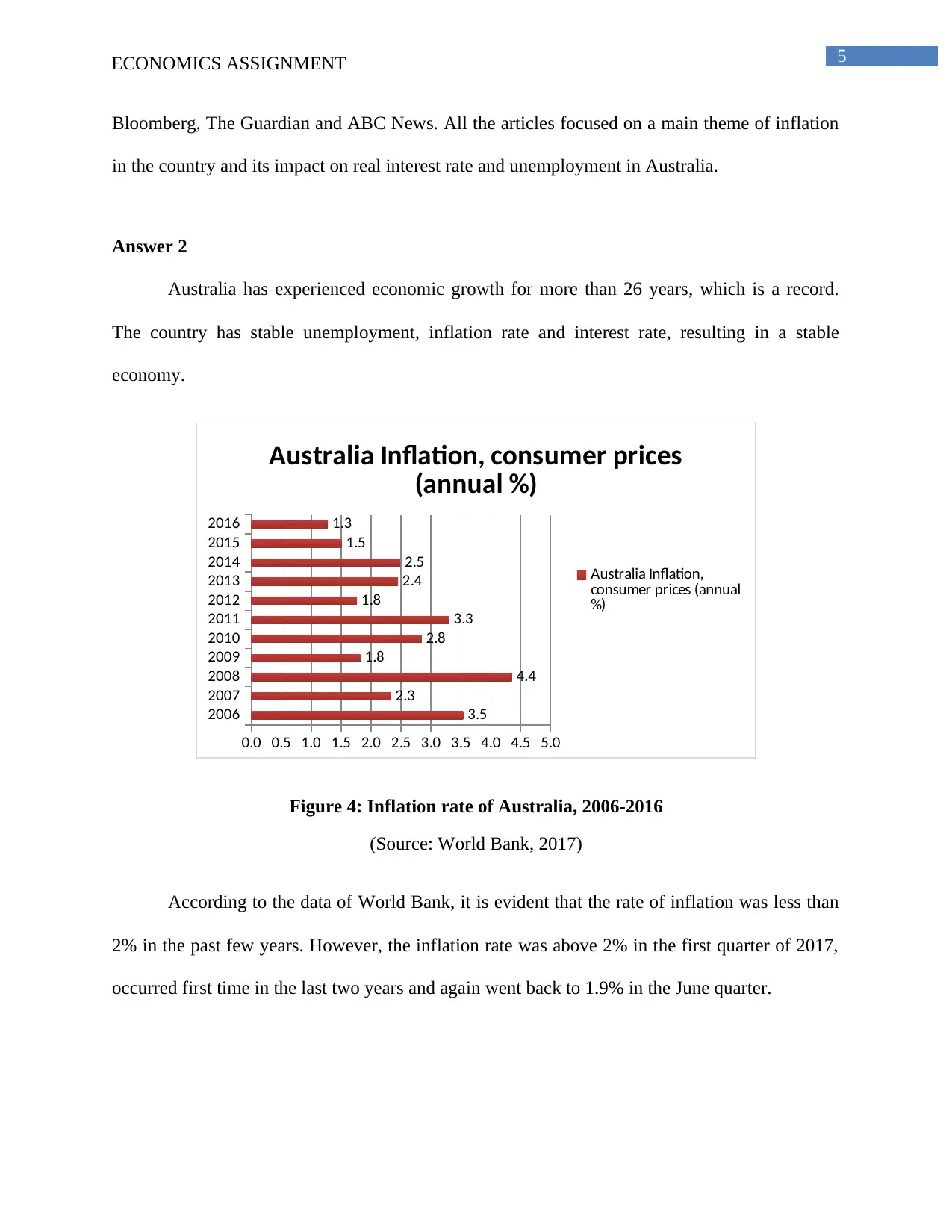
5ECONOMICS ASSIGNMENT
Bloomberg, The Guardian and ABC News. All the articles focused on a main theme of inflation
in the country and its impact on real interest rate and unemployment in Australia.
Answer 2
Australia has experienced economic growth for more than 26 years, which is a record.
The country has stable unemployment, inflation rate and interest rate, resulting in a stable
economy.
2006
2007
2008
2009
2010
2011
2012
2013
2014
2015
2016
0.0 0.5 1.0 1.5 2.0 2.5 3.0 3.5 4.0 4.5 5.0
3.5
2.3
4.4
1.8
2.8
3.3
1.8
2.4
2.5
1.5
1.3
Australia Inflation, consumer prices
(annual %)
Australia Inflation,
consumer prices (annual
%)
Figure 4: Inflation rate of Australia, 2006-2016
(Source: World Bank, 2017)
According to the data of World Bank, it is evident that the rate of inflation was less than
2% in the past few years. However, the inflation rate was above 2% in the first quarter of 2017,
occurred first time in the last two years and again went back to 1.9% in the June quarter.
Bloomberg, The Guardian and ABC News. All the articles focused on a main theme of inflation
in the country and its impact on real interest rate and unemployment in Australia.
Answer 2
Australia has experienced economic growth for more than 26 years, which is a record.
The country has stable unemployment, inflation rate and interest rate, resulting in a stable
economy.
2006
2007
2008
2009
2010
2011
2012
2013
2014
2015
2016
0.0 0.5 1.0 1.5 2.0 2.5 3.0 3.5 4.0 4.5 5.0
3.5
2.3
4.4
1.8
2.8
3.3
1.8
2.4
2.5
1.5
1.3
Australia Inflation, consumer prices
(annual %)
Australia Inflation,
consumer prices (annual
%)
Figure 4: Inflation rate of Australia, 2006-2016
(Source: World Bank, 2017)
According to the data of World Bank, it is evident that the rate of inflation was less than
2% in the past few years. However, the inflation rate was above 2% in the first quarter of 2017,
occurred first time in the last two years and again went back to 1.9% in the June quarter.
⊘ This is a preview!⊘
Do you want full access?
Subscribe today to unlock all pages.

Trusted by 1+ million students worldwide
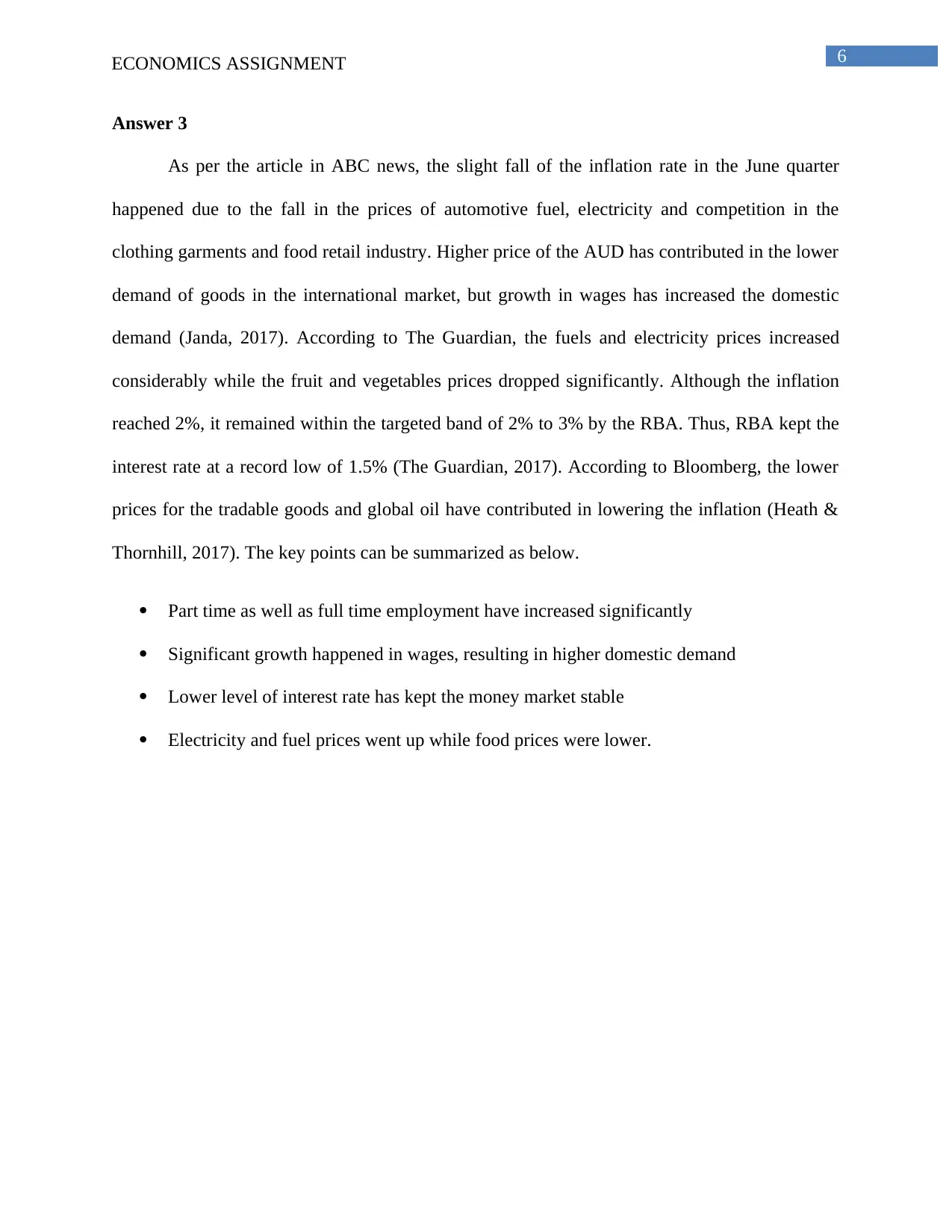
6ECONOMICS ASSIGNMENT
Answer 3
As per the article in ABC news, the slight fall of the inflation rate in the June quarter
happened due to the fall in the prices of automotive fuel, electricity and competition in the
clothing garments and food retail industry. Higher price of the AUD has contributed in the lower
demand of goods in the international market, but growth in wages has increased the domestic
demand (Janda, 2017). According to The Guardian, the fuels and electricity prices increased
considerably while the fruit and vegetables prices dropped significantly. Although the inflation
reached 2%, it remained within the targeted band of 2% to 3% by the RBA. Thus, RBA kept the
interest rate at a record low of 1.5% (The Guardian, 2017). According to Bloomberg, the lower
prices for the tradable goods and global oil have contributed in lowering the inflation (Heath &
Thornhill, 2017). The key points can be summarized as below.
Part time as well as full time employment have increased significantly
Significant growth happened in wages, resulting in higher domestic demand
Lower level of interest rate has kept the money market stable
Electricity and fuel prices went up while food prices were lower.
Answer 3
As per the article in ABC news, the slight fall of the inflation rate in the June quarter
happened due to the fall in the prices of automotive fuel, electricity and competition in the
clothing garments and food retail industry. Higher price of the AUD has contributed in the lower
demand of goods in the international market, but growth in wages has increased the domestic
demand (Janda, 2017). According to The Guardian, the fuels and electricity prices increased
considerably while the fruit and vegetables prices dropped significantly. Although the inflation
reached 2%, it remained within the targeted band of 2% to 3% by the RBA. Thus, RBA kept the
interest rate at a record low of 1.5% (The Guardian, 2017). According to Bloomberg, the lower
prices for the tradable goods and global oil have contributed in lowering the inflation (Heath &
Thornhill, 2017). The key points can be summarized as below.
Part time as well as full time employment have increased significantly
Significant growth happened in wages, resulting in higher domestic demand
Lower level of interest rate has kept the money market stable
Electricity and fuel prices went up while food prices were lower.
Paraphrase This Document
Need a fresh take? Get an instant paraphrase of this document with our AI Paraphraser
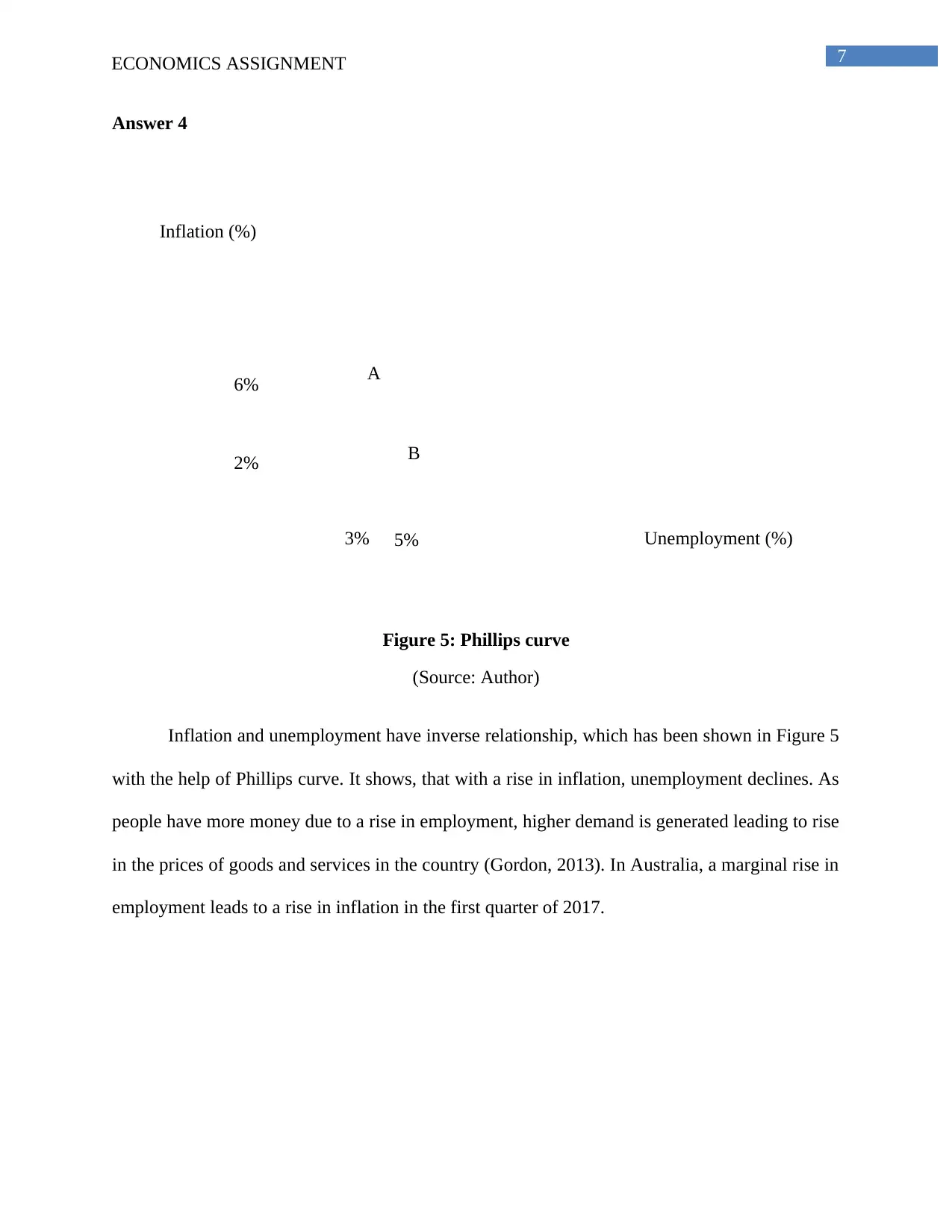
7ECONOMICS ASSIGNMENT
Inflation (%)
Unemployment (%)
6%
5%3%
2%
A
B
Answer 4
Figure 5: Phillips curve
(Source: Author)
Inflation and unemployment have inverse relationship, which has been shown in Figure 5
with the help of Phillips curve. It shows, that with a rise in inflation, unemployment declines. As
people have more money due to a rise in employment, higher demand is generated leading to rise
in the prices of goods and services in the country (Gordon, 2013). In Australia, a marginal rise in
employment leads to a rise in inflation in the first quarter of 2017.
Inflation (%)
Unemployment (%)
6%
5%3%
2%
A
B
Answer 4
Figure 5: Phillips curve
(Source: Author)
Inflation and unemployment have inverse relationship, which has been shown in Figure 5
with the help of Phillips curve. It shows, that with a rise in inflation, unemployment declines. As
people have more money due to a rise in employment, higher demand is generated leading to rise
in the prices of goods and services in the country (Gordon, 2013). In Australia, a marginal rise in
employment leads to a rise in inflation in the first quarter of 2017.
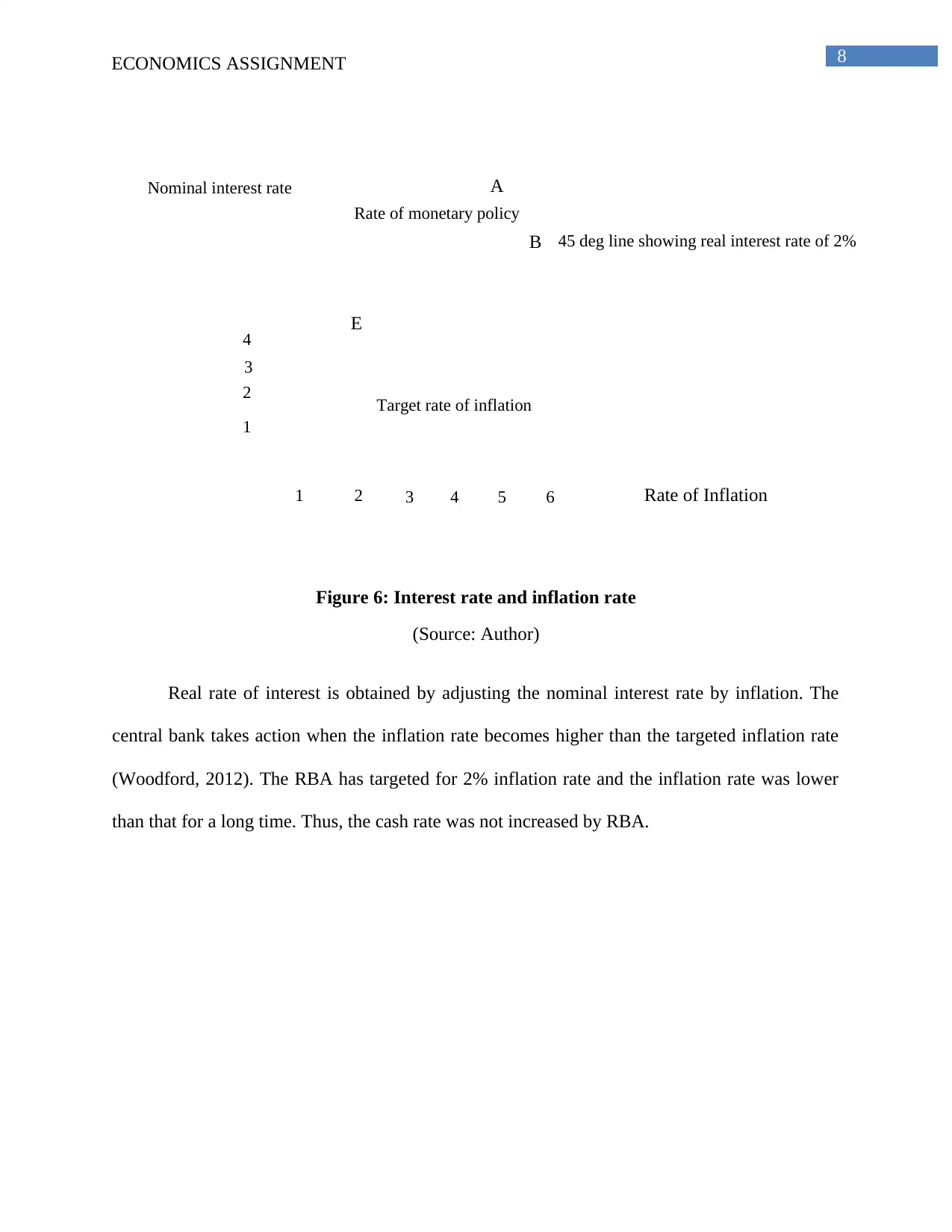
8ECONOMICS ASSIGNMENT
Nominal interest rate
Rate of Inflation
B
A
E
Target rate of inflation
Rate of monetary policy
4321
4
3
2
1
5 6
45 deg line showing real interest rate of 2%
Figure 6: Interest rate and inflation rate
(Source: Author)
Real rate of interest is obtained by adjusting the nominal interest rate by inflation. The
central bank takes action when the inflation rate becomes higher than the targeted inflation rate
(Woodford, 2012). The RBA has targeted for 2% inflation rate and the inflation rate was lower
than that for a long time. Thus, the cash rate was not increased by RBA.
Nominal interest rate
Rate of Inflation
B
A
E
Target rate of inflation
Rate of monetary policy
4321
4
3
2
1
5 6
45 deg line showing real interest rate of 2%
Figure 6: Interest rate and inflation rate
(Source: Author)
Real rate of interest is obtained by adjusting the nominal interest rate by inflation. The
central bank takes action when the inflation rate becomes higher than the targeted inflation rate
(Woodford, 2012). The RBA has targeted for 2% inflation rate and the inflation rate was lower
than that for a long time. Thus, the cash rate was not increased by RBA.
⊘ This is a preview!⊘
Do you want full access?
Subscribe today to unlock all pages.

Trusted by 1+ million students worldwide
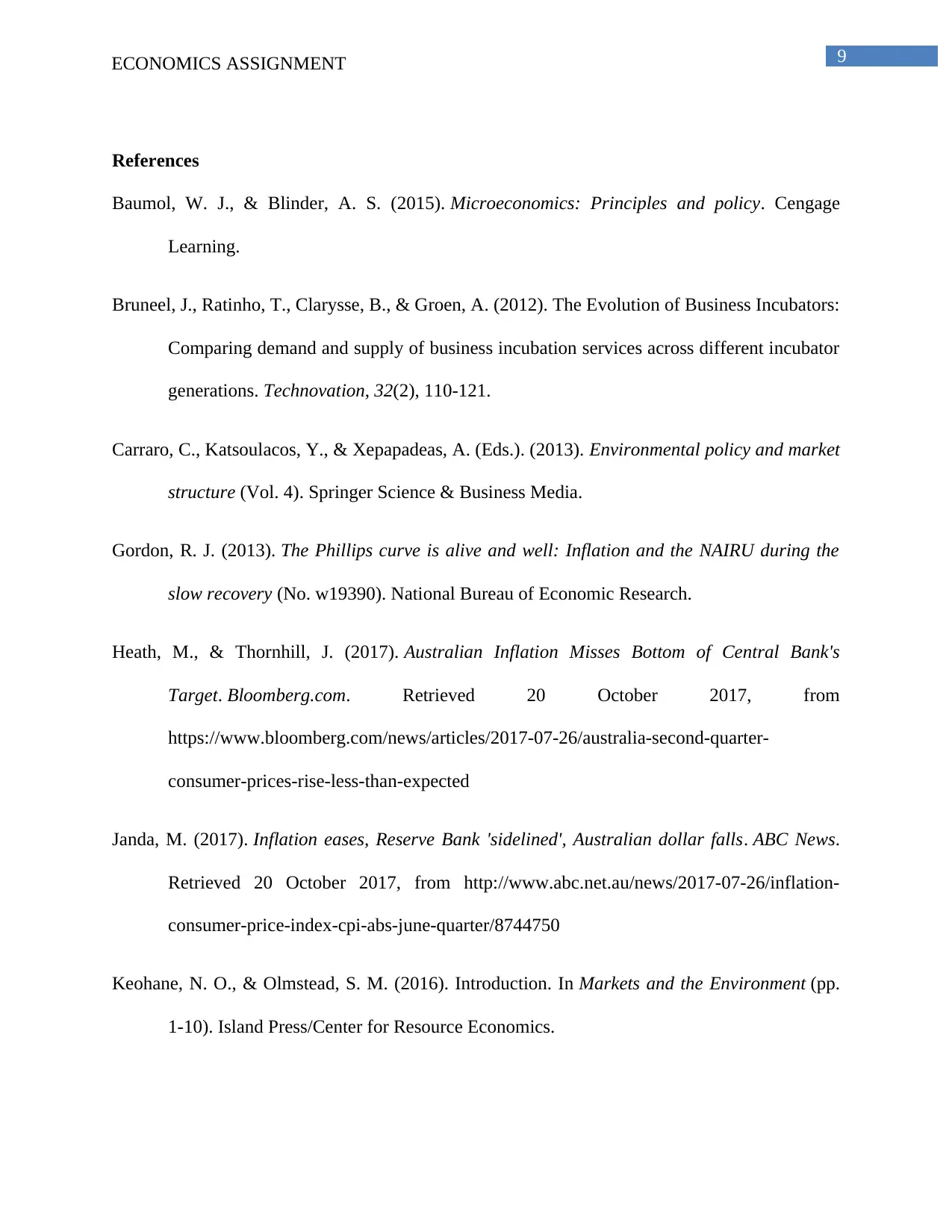
9ECONOMICS ASSIGNMENT
References
Baumol, W. J., & Blinder, A. S. (2015). Microeconomics: Principles and policy. Cengage
Learning.
Bruneel, J., Ratinho, T., Clarysse, B., & Groen, A. (2012). The Evolution of Business Incubators:
Comparing demand and supply of business incubation services across different incubator
generations. Technovation, 32(2), 110-121.
Carraro, C., Katsoulacos, Y., & Xepapadeas, A. (Eds.). (2013). Environmental policy and market
structure (Vol. 4). Springer Science & Business Media.
Gordon, R. J. (2013). The Phillips curve is alive and well: Inflation and the NAIRU during the
slow recovery (No. w19390). National Bureau of Economic Research.
Heath, M., & Thornhill, J. (2017). Australian Inflation Misses Bottom of Central Bank's
Target. Bloomberg.com. Retrieved 20 October 2017, from
https://www.bloomberg.com/news/articles/2017-07-26/australia-second-quarter-
consumer-prices-rise-less-than-expected
Janda, M. (2017). Inflation eases, Reserve Bank 'sidelined', Australian dollar falls. ABC News.
Retrieved 20 October 2017, from http://www.abc.net.au/news/2017-07-26/inflation-
consumer-price-index-cpi-abs-june-quarter/8744750
Keohane, N. O., & Olmstead, S. M. (2016). Introduction. In Markets and the Environment (pp.
1-10). Island Press/Center for Resource Economics.
References
Baumol, W. J., & Blinder, A. S. (2015). Microeconomics: Principles and policy. Cengage
Learning.
Bruneel, J., Ratinho, T., Clarysse, B., & Groen, A. (2012). The Evolution of Business Incubators:
Comparing demand and supply of business incubation services across different incubator
generations. Technovation, 32(2), 110-121.
Carraro, C., Katsoulacos, Y., & Xepapadeas, A. (Eds.). (2013). Environmental policy and market
structure (Vol. 4). Springer Science & Business Media.
Gordon, R. J. (2013). The Phillips curve is alive and well: Inflation and the NAIRU during the
slow recovery (No. w19390). National Bureau of Economic Research.
Heath, M., & Thornhill, J. (2017). Australian Inflation Misses Bottom of Central Bank's
Target. Bloomberg.com. Retrieved 20 October 2017, from
https://www.bloomberg.com/news/articles/2017-07-26/australia-second-quarter-
consumer-prices-rise-less-than-expected
Janda, M. (2017). Inflation eases, Reserve Bank 'sidelined', Australian dollar falls. ABC News.
Retrieved 20 October 2017, from http://www.abc.net.au/news/2017-07-26/inflation-
consumer-price-index-cpi-abs-june-quarter/8744750
Keohane, N. O., & Olmstead, S. M. (2016). Introduction. In Markets and the Environment (pp.
1-10). Island Press/Center for Resource Economics.
Paraphrase This Document
Need a fresh take? Get an instant paraphrase of this document with our AI Paraphraser
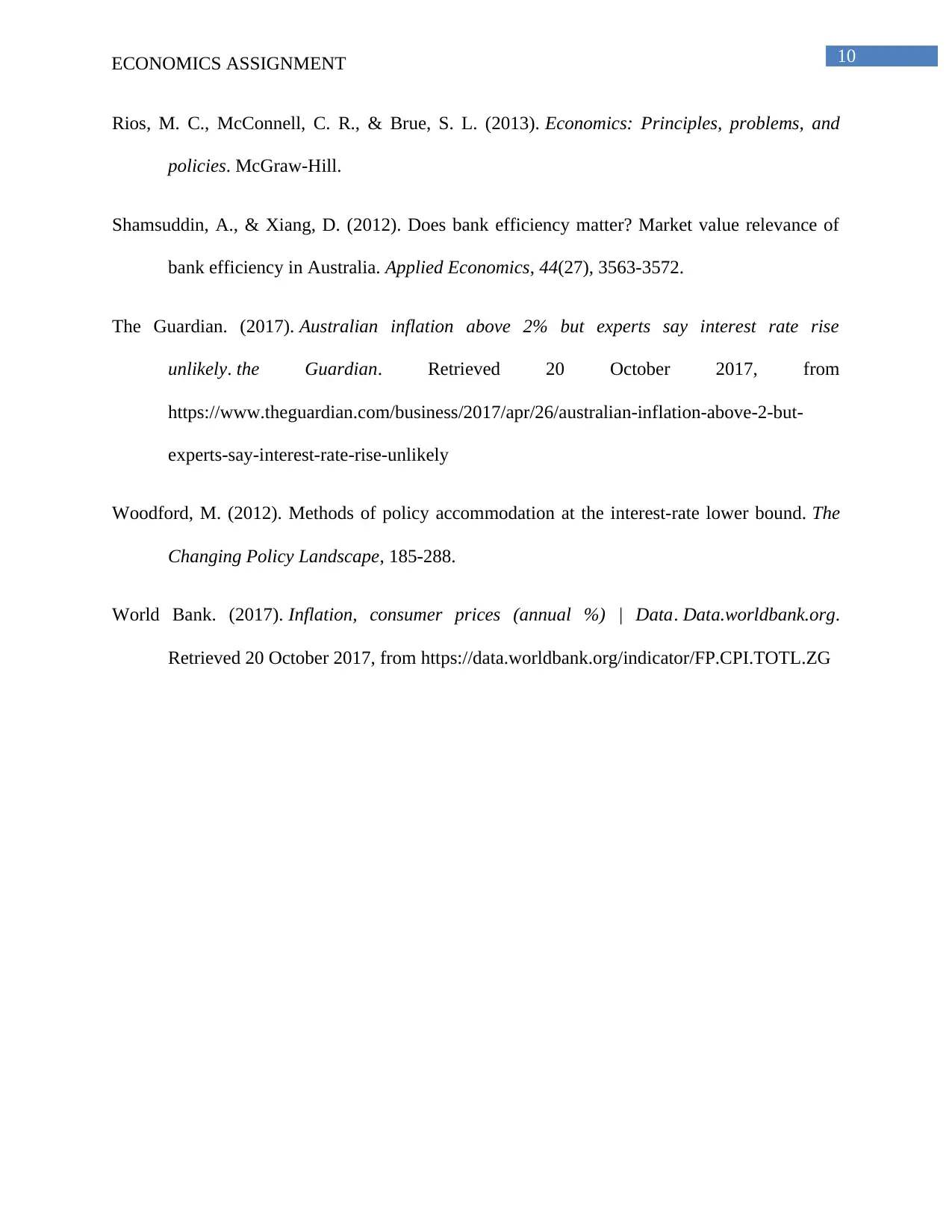
10ECONOMICS ASSIGNMENT
Rios, M. C., McConnell, C. R., & Brue, S. L. (2013). Economics: Principles, problems, and
policies. McGraw-Hill.
Shamsuddin, A., & Xiang, D. (2012). Does bank efficiency matter? Market value relevance of
bank efficiency in Australia. Applied Economics, 44(27), 3563-3572.
The Guardian. (2017). Australian inflation above 2% but experts say interest rate rise
unlikely. the Guardian. Retrieved 20 October 2017, from
https://www.theguardian.com/business/2017/apr/26/australian-inflation-above-2-but-
experts-say-interest-rate-rise-unlikely
Woodford, M. (2012). Methods of policy accommodation at the interest-rate lower bound. The
Changing Policy Landscape, 185-288.
World Bank. (2017). Inflation, consumer prices (annual %) | Data. Data.worldbank.org.
Retrieved 20 October 2017, from https://data.worldbank.org/indicator/FP.CPI.TOTL.ZG
Rios, M. C., McConnell, C. R., & Brue, S. L. (2013). Economics: Principles, problems, and
policies. McGraw-Hill.
Shamsuddin, A., & Xiang, D. (2012). Does bank efficiency matter? Market value relevance of
bank efficiency in Australia. Applied Economics, 44(27), 3563-3572.
The Guardian. (2017). Australian inflation above 2% but experts say interest rate rise
unlikely. the Guardian. Retrieved 20 October 2017, from
https://www.theguardian.com/business/2017/apr/26/australian-inflation-above-2-but-
experts-say-interest-rate-rise-unlikely
Woodford, M. (2012). Methods of policy accommodation at the interest-rate lower bound. The
Changing Policy Landscape, 185-288.
World Bank. (2017). Inflation, consumer prices (annual %) | Data. Data.worldbank.org.
Retrieved 20 October 2017, from https://data.worldbank.org/indicator/FP.CPI.TOTL.ZG
1 out of 11
Related Documents
Your All-in-One AI-Powered Toolkit for Academic Success.
+13062052269
info@desklib.com
Available 24*7 on WhatsApp / Email
![[object Object]](/_next/static/media/star-bottom.7253800d.svg)
Unlock your academic potential
© 2024 | Zucol Services PVT LTD | All rights reserved.




